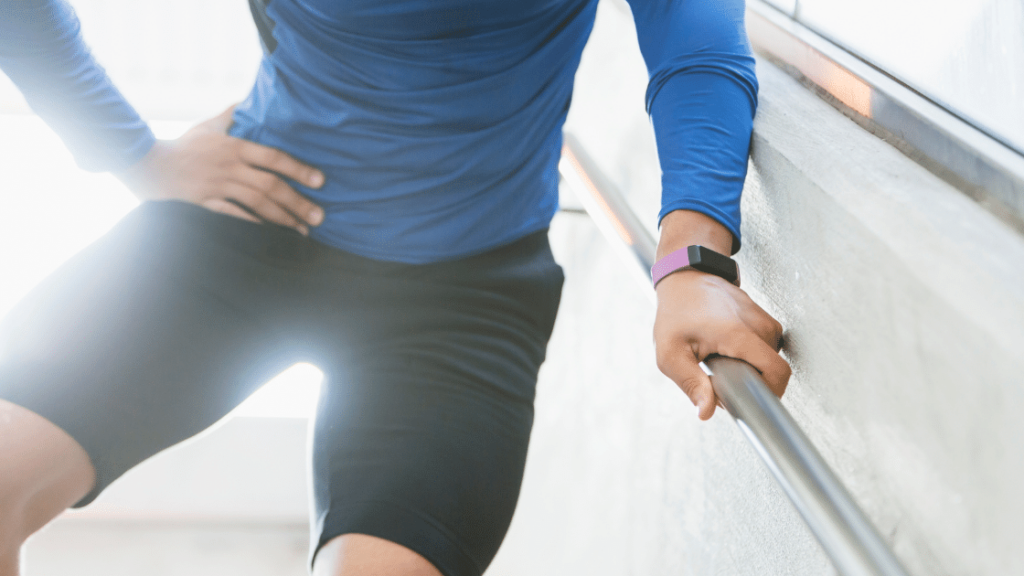IT Band Syndrome

Everyone has a tight IT band. The IT band, or iliotibial tract, functions like a tough tendon and not so much like a muscle. And they’re tight for a reason, as their job is to attach muscle to bone. They have to be tough to do that effectively!
But some people have extra tight IT bands that are in constant discomfort. If this is the case, IT band syndrome may be to blame. But what exactly causes IT band syndrome? What undesirable symptoms come along with it? And what is the best way to treat it?
What Causes IT Band Syndrome?
Overuse of the knee is often the cause, but a tightness in the hip or side of the upper leg can contribute as well.
Here’s an anatomy lesson! The origin site of the IT band is the iliac crest in the pelvis, and the insertion site crosses over the knee and attaches to the shin bone. The fibrous IT band stretches across the lateral side of the thigh. Pulling and tightening the tract with each flex of the leg, knee overuse is what causes IT band syndrome. When the knee is repeatedly bent during physical activity, the IT band can become so tight that it rubs up against the thigh bone beneath it — ouch. Activities that run the risk of causing it include running, biking, swimming, and climbing.
What Does IT Band Syndrome Feel Like?
The pain will stretch from just under the knee and travel into the side of the hip, intensifying with physical activity. The pain can be sharp and tender, and flexibility can be limited. Swelling may also occur.
How to Treat IT Band Syndrome
The symptoms will often last a few weeks but can continue for a few months. When treated early, the chances of it becoming chronic lessen significantly. A person with IT band syndrome should seek treatment as soon as possible following the diagnosis.
Chiropractic Care
-
- This can be especially helpful if the syndrome stems from pelvic dysfunction. Spinal adjustments will put the pelvis into proper alignment, making the pelvis more functional
- Chiropractors can also use laser therapy to relieve pain and inflammation. Laser therapy uses light beams to speed up the body’s healing process. When absorbed into the body, the light reduces nerve sensitivity and suppresses pain evoking chemicals.
- Active release therapy (ART) is commonly used for IT band syndrome. The goal of ART is to improve joint range of motion. Flexible muscles allow the body to function more efficiently, decreasing the chance of further injury.
Massage Therapy
-
- Sports massage techniques can be similar to ART. Proprioceptive neuromuscular facilitation (PNF) uses assisted resistance to improve range of motion, and pin-and-stretch can break up muscular adhesions while a muscle is in motion.
- Most massage modalities are effective and safe for IT band syndrome. A relaxation massage warms muscular tissue to loosen it up, and it also releases pain-reducing chemicals. A deep tissue massage does the same, but can also break up adhesions.
- A deep tissue massage should never be painful on the IT band, however. The IT band is very sensitive, and excessive pressure can cause the band to tense up and be unable to relax. Communicating any pain to the therapist is important.
Acupuncture
-
- Acupuncture can be used to treat any pain, swelling, tightness, or dysfunction of the IT band. There are specific points in the body that correlate with the IT band, as well as points for the areas causing the IT band syndrome.
At-Home Remedies
-
- Roll a tennis ball between the hip and a wall
- Slide a rolling pin up and down the surface of the IT band
- Check out this article for a good read about rolling pins!
- Place a cold pack on the painful areas for 10 to 15 minutes at a time, four times per day.
- Rest. Don’t overwork that poor IT band while it’s syndroming. Be kind to it and let it rest!
Now you know all about IT band syndrome! Stay happy, healthy, and come in for a free consultation if you’re having hip pain!

Katrina Jenkins
Author, Licensed Massage Therapist
Katrina Jenkins graduated from Towson University in 2013 with a Bachelor’s Degree in Health Science and worked as a nurse’s aide briefly before pursuing her true passion. She graduated from the Massage Therapy Institute of Colorado in April 2016 with honors and completed the Touch of Healers Scholarship Program the following summer. She has been a part of the Moyer Total Wellness Team since the summer of 2017.
Photo Credit:
Canva by kali9 from Getty Images Signature
Resources:
Ackerman, Aurélie, et al. “Iliotibial Band Syndrome.” Physiopedia, www.physio-pedia.com/Iliotibial_Band_Syndrome.
Beals, Corey, and David Flanigan. “A Review of Treatments for Iliotibial Band Syndrome in the Athletic Population.” Journal of Sports Medicine (Hindawi Publishing Corporation), Hindawi Publishing Corporation, 2013, www.ncbi.nlm.nih.gov/pmc/articles/PMC4590904/.
Wedro, Benjamin. “IT Band Syndrome: Treatment, Exercises, Symptoms, Recovery Time.” MedicineNet, MedicineNet, 10 Mar. 2020, www.medicinenet.com/iliotibial_band_syndrome/article.htm.
Wheeler, Tyler. “Iliotibial (IT) Band Syndrome: Causes, Symptoms, Treatment.” WebMD, WebMD, 27 May 2019, www.webmd.com/pain-management/it-band-syndrome.
